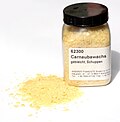Carnauba wax
Carnauba Wax is a type of wax derived from the leaves of the palm tree species Copernicia prunifera, commonly known as the carnauba tree. Native to Brazil, the carnauba tree thrives in the northeastern regions of the country where the climate is hot and humid.
Production[edit]
The production of carnauba wax is a labor-intensive process. The leaves of the carnauba tree are harvested during the dry season, typically from September to March. After harvesting, the leaves are left to dry in the sun. Once dry, they are beaten to loosen the wax, which is then refined into a usable product.
Properties[edit]
Carnauba wax is known for its hardness and high melting point, which is around 82-86 degrees Celsius. It is also highly durable and has a glossy finish, making it a popular choice for various applications. Carnauba wax is insoluble in water and can resist humidity, which contributes to its long-lasting properties.
Uses[edit]
Carnauba wax has a wide range of uses across various industries. In the food industry, it is used as a coating to give confectionery items a shiny appearance. It is also used in the cosmetics industry for products like lipstick and mascara due to its hypoallergenic and emollient properties. In the automotive industry, carnauba wax is used in car waxes and polishes for its high gloss and durability. It is also used in the production of musical instruments, particularly wind instruments, for its ability to provide a high-gloss finish and protect the instrument from humidity.
Environmental Impact[edit]
Carnauba wax is a renewable resource, as the trees are not harmed during the harvesting process. However, the labor-intensive nature of its production and the conditions under which it is produced have raised concerns about the sustainability and ethical implications of its use.
See Also[edit]
-
Carnauba wax flakes
-
Carnauba palm tree
-
Carnauba wax coated candies
Ad. Transform your life with W8MD's Budget GLP-1 injections from $75


W8MD offers a medical weight loss program to lose weight in Philadelphia. Our physician-supervised medical weight loss provides:
- Weight loss injections in NYC (generic and brand names):
- Zepbound / Mounjaro, Wegovy / Ozempic, Saxenda
- Most insurances accepted or discounted self-pay rates. We will obtain insurance prior authorizations if needed.
- Generic GLP1 weight loss injections from $75 for the starting dose.
- Also offer prescription weight loss medications including Phentermine, Qsymia, Diethylpropion, Contrave etc.
NYC weight loss doctor appointmentsNYC weight loss doctor appointments
Start your NYC weight loss journey today at our NYC medical weight loss and Philadelphia medical weight loss clinics.
- Call 718-946-5500 to lose weight in NYC or for medical weight loss in Philadelphia 215-676-2334.
- Tags:NYC medical weight loss, Philadelphia lose weight Zepbound NYC, Budget GLP1 weight loss injections, Wegovy Philadelphia, Wegovy NYC, Philadelphia medical weight loss, Brookly weight loss and Wegovy NYC
|
WikiMD's Wellness Encyclopedia |
| Let Food Be Thy Medicine Medicine Thy Food - Hippocrates |
Medical Disclaimer: WikiMD is not a substitute for professional medical advice. The information on WikiMD is provided as an information resource only, may be incorrect, outdated or misleading, and is not to be used or relied on for any diagnostic or treatment purposes. Please consult your health care provider before making any healthcare decisions or for guidance about a specific medical condition. WikiMD expressly disclaims responsibility, and shall have no liability, for any damages, loss, injury, or liability whatsoever suffered as a result of your reliance on the information contained in this site. By visiting this site you agree to the foregoing terms and conditions, which may from time to time be changed or supplemented by WikiMD. If you do not agree to the foregoing terms and conditions, you should not enter or use this site. See full disclaimer.
Credits:Most images are courtesy of Wikimedia commons, and templates, categories Wikipedia, licensed under CC BY SA or similar.
Translate this page: - East Asian
中文,
日本,
한국어,
South Asian
हिन्दी,
தமிழ்,
తెలుగు,
Urdu,
ಕನ್ನಡ,
Southeast Asian
Indonesian,
Vietnamese,
Thai,
မြန်မာဘာသာ,
বাংলা
European
español,
Deutsch,
français,
Greek,
português do Brasil,
polski,
română,
русский,
Nederlands,
norsk,
svenska,
suomi,
Italian
Middle Eastern & African
عربى,
Turkish,
Persian,
Hebrew,
Afrikaans,
isiZulu,
Kiswahili,
Other
Bulgarian,
Hungarian,
Czech,
Swedish,
മലയാളം,
मराठी,
ਪੰਜਾਬੀ,
ગુજરાતી,
Portuguese,
Ukrainian



